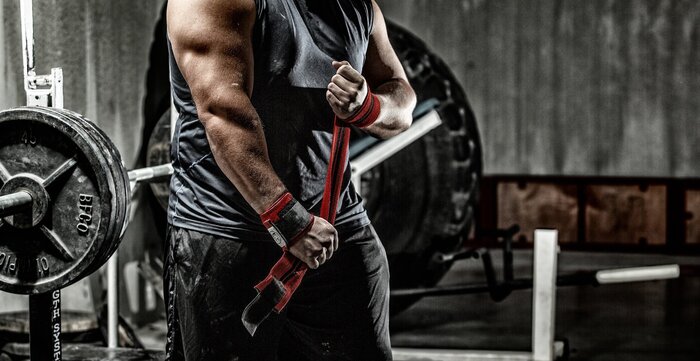
One-Rep Max Calculator: Target Max Strength Goals
Calculate your max for any lift with this 1RM calculator. Get strategic about getting bigger, stronger, and faster!
One-Rep Max Calculator
Your One-Rep Max (one-rm): ?
90%: ?
85%: ?
80%: ?
75%: ?
65%: ?
60%: ?
55%: ?
50%: ?
Now that you know your estimated 1RM and lifting percentages, here are your next steps.
1. Pick a strength training plan.
Get to work raising that one-rep max in these BodyFit programs that are all structured around strength or percentage-based lifting.
2. Gear up.
If you're entering a training phase where you'll be consistently above 80 percent, consider investing in a few heavy-lifting-focused accessories. A few you'll find in the gym bags of most serious lifters include:
- Lifting belt to promote bracing and protect your back
- Wrist wraps and/or elbow sleeves for more stable and comfortable pressing
- Wrist straps to support your grip on heavy pulls
- Knee sleeves to support your knees during heavy squats or Olympic lifts
Everything changes when you're lifting heavy. Prep your gym bag for stronger, safer lifts, and you'll never regret it.
3. Join the world’s strongest fitness community.
For over 10 years, members of BodySpace have been helping each other build their best bodies. Join a fitness community that's over 2 million people strong!
How Do I Test My One-Rep Max?
Trainers and coaches often set up programs with percentages based on your one-rep max (1RM) because they don't know your actual strength level, but they know what percentages they want you to be using relative to your 1RM. Here are some important caveats to remember when using them:
- The lower the number of reps you enter in, the more accurate your 1RM will be. In other words, a three-rep max (3RM) will give you a better estimate than a 12RM.
- Stop your set once your form is at risk of breaking down, or your range of motion is decreasing. No 1RM is worth getting injured and having to stop training.
- Remember that each exercise has its own 1RM. Don't use your back squat 1RM to compute your front squat. Strength is specific!
- Really want to know your 1RM? Test it the right way. World-class powerlifter Layne Norton, Ph.D., can show you how.
What Percentage of My One-Rep Max Should I Lift?
The answer to this question varies wildly based on your goal, your training plan's style of progressive overload, and even what phase or day of that program you're in. Totally in the dark? These are the most popular starting points for percentages and sets and reps for specific goals:
Speed and power: 50-60 percent, 3-5 reps per set
Muscle size: 70-80 percent, 8-12 reps per set
Strength: 85-95 percent, 3-5 reps per set
But there's nothing magical about those numbers, or about the traditional bodybuilding set and rep scheme of 3 sets of 8-12 reps at 70-75 percent. In fact, if that's all you do, you're probably leaving muscle gains on the table! In "The New Science of Size and Strength," researcher and competitive bodybuilder Adam Gonzalez, Ph.D., advocates alternating 4-8-week training "blocks" of 10-12 reps at 70 percent with blocks of higher intensity, like 3-5 reps with 90 percent. Both approaches have been shown in recent research to achieve similar muscular gains.
Creatine has consistently been shown to improve maximum strength. If you're chasing a new 1RM, 5 g a day is a no-brainer.* - View All
How Do I Use My One-Rep Max in a Workout?
You might think your 1RM doesn't matter, because you'll never train that heavy on most lifts anyway. But then, one day, you see a program that asks you to use 70 percent of your 1RM on a lift. When that happens, use this calculator to guide you.
If you don't want to pull it up and plug in the numbers each time, download the 1RM App, which saves and tracks your 1RM and percentages for multiple lifts.
Some programs are set up a little differently and will instead tell you to lift with your 3RM, 6RM, or some other number. What's different here is that instead of a giving you a percentage of your 1RM, you'll see 3RM, which indicates you should use a weight that you can do for only 3 reps. You'll need the table below to essentially do the conversion in a different way.
| 1RM % | Rep Max |
|---|---|
| 100% | 1RM |
| 95 | 2RM |
| 93 | 3RM |
| 90 | 4RM |
| 87 | 5RM |
| 85 | 6RM |
| 83 | 7RM |
| 80 | 8RM |
| 77 | 9RM |
| 75 | 10RM |
| 73 | 11RM |
| 70 | 12RM |
Just remember that these are estimates and won't always hold true. For example, because a squat uses more muscle than a curl, one study found that lifters could knock out more reps at 60, 80, and 90 percent than they could with curls.
Likewise, rep maxes can fluctuate daily, based on everything from how well you slept to how recovered you are from your previous workouts. So if you find that last week's 8RM is now a 5RM, don't be afraid to lighten the weight for a workout.
What are the Best Programs to Increase My One-Rep Max Strength?
Now that you know your percentages, put them to work in these BodyFit programs that are all structured around percentage-based lifting.








